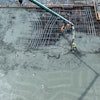In a previous position, Ward was reviewing a document that dealt with slab-on-ground construction. One of that document’s co-authors—a staff engineer—had included a thickness tolerance of minus ¼ in., plus 3/8 in. In talking with him, Ward suggested that even though this tolerance was published in ACI 117-90, “Tolerances for Concrete Construction and Materials,” it was seldom met.
That resulted in the following conversation:
Staff engineer: “I disagree. Even the ¼-inch tolerance is too big. It should be 1/8-inch”
Ward: “That’s really extreme. The available data indicates there is a low probability of meeting the minus ¼-inch tolerance. Based on more than 2,000 core measurements on seven different projects, the average standard deviation for slab thickness is ½ inch. So the target thickness would have to be about 1-1/2 inch (three standard deviation units) greater than the design thickness, far exceeding the plus tolerance.”
Staff engineer: “It can be done! I’ve done it.”
(End of conversation.)
Ward had just witnessed the use of a result based on one person’s experience: an anecdote. “An anecdote is really a data set with a sample size of only one. You have no information to compare it to, no statistics to analyze, no possible explanations or information to go on—just a single story.”1
So lets’ examine the use of anecdotes.
Hasty generalizations
If one construction team including this engineer, excavating contractor, concrete producer, and concrete contractor had “done it,” does that mean that any construction team could do it? We think not. As with almost any group of competitors for a project, there are very good, average, and poor companies, with project superintendents that might also fall into those categories.
And within the population of contractors’ trades people—equipment operators, form setters, laborers, and finishers—we also find variations in skills, experience, and knowledge. Just because one group may have done it once doesn’t mean most contractors’ teams can do it.
Here’s a sports analogy to illustrate the point. Can a basketball team from a public school with only 98 students win a state championship while playing against teams from much larger schools? It happened in Illinois, where the term “March Madness” originated. In 1952, Hebron High School won it all in a one-class tournament. Does that prove that small schools can compete on an equal footing with large schools in basketball? Nope. No small-school team in Illinois ever duplicated the David vs. Goliath Hebron win.
And we don’t think any concrete contractor could duplicate the minus-1/8-inch tolerance accomplishment claimed by the staff engineer, if indeed there was any proof that it happened.
The plural of anecdote is not data
After Ward’s conversation, he wanted to ask how the staff engineer was certain he had done it—you know, as in “Show me the data.” Most often there is no data and, if there is, the result may be an outlier from the norm.
Don’t underestimate the power of anecdotes, however, especially if one is followed by a similar account in an association’s technical committee meeting. One anecdote from an esteemed industry authority, followed by a confirming eye-witness account from one or more other committee members, often seals the deal. It may be acceptable to make decisions based on anecdotes, in the absence of data, but when data become available these decisions should be based on real data from careful research.
Correlation does not imply causation
In a discussion about the advisability of placing concrete slabs-on-ground directly on a vapor retarder instead of a blotter layer, because the floors would be covered with a moisture-sensitive flooring material, the following discussion ensued:
Participant 1: “I placed a concrete floor slab directly on a vapor retarder for a job in Colorado, and within hours, there were plastic shrinkage cracks all over the slab.”
Participant 2: “On what day of the week did you place that concrete?”
Participant 1: “Thursday.”
Participant 2: “Don’t ever place concrete directly on a vapor retarder on a Thursday.”
(Problem solved.)
OK. We made up part of that story. But too often people subscribe to the notion that correlation equals causation, based on an anecdote or two that seems to prove their point. Sometimes the correlation between vapor retarders and plastic cracking is even supported by research2 that later proves to be of doubtful value because of atypical concrete properties.3
Here’s a takeaway, based on just one more example. We can say concrete strength decreases with an increase in concrete slump, but only with the assumption that slump is controlled by water content, and all other factors affecting slump are unchanged. How likely is that? There are many variables that affect concrete strength, and attributing a strength decrease to only one variable often masks the effect of a more important variable. Anecdotal information often results in the correlation-causation trap.
Again, data is king. With enough data we can better detect the more important variables that we hope can be controlled.
Epilogue
In the revisions of the tolerance document following ACI 117-90, published in 2006, 2010, and 2015, the tolerance had changed. There was no plus thickness tolerance for slabs-on-ground, and the minus tolerance was based on a minimum of four samples per 5,000 square feet of slab. The allowable average thickness of all slab samples was minus 3/8 inch, and no individual sample thickness could be less than minus ¾ inch of the design thickness. For a six-inch-thick slab the average thickness should not be less than 5-5/8 inch and no individual sample should be less than 5-1/4 in. Even this more lenient tolerance is difficult to meet but at least data, not anecdotes, convinced the committee that a change was needed.
When someone tries to persuade you by telling you an anecdote, just say: “Show me the data.”
References
- Rumsey, Deborah, Statistics for Dummies, Wiley Publishing, Inc., 2011, pp. 40 and 330.
- Nicholson, L. P., “How to Minimize Cracking and Increase Strength of Slabs on Grade,” Concrete Construction, Sept., 1981, pp. 739-741.
- Suprenant, Bruce A., “Vapor Barriers Under Concrete Slabs,” Concrete Construction, April 1992, pp. 292-296.















